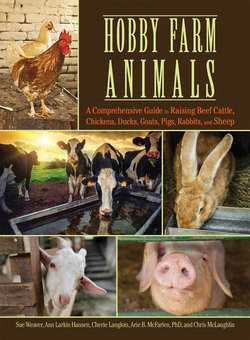Читать книгу Hobby Farm Animals - Chris McLaughlin - Страница 49
На сайте Литреса книга снята с продажи.
Your Coop: Basic Furnishings
ОглавлениеBasic coop furnishings include roosts, nest boxes for laying hens, feeders, and watering stations. Roosts are the elevated poles or boards on which chickens prefer to sleep. Roosting helps them feel safer at night, making these perches a must if you want happy hens. Nesting boxes are a necessity—unless you like going on egg hunts or prefer your eggs precracked. You’ll also need more than one set of well-placed waterers and feeders.
Roosts
In the winter, roosted birds fluff their feathers and cover their toes; they tend to stay warmer that way. A roost can be as simple as an old wooden ladder propped against a chicken coop’s inner wall and tacked to the wall at the top. Place it at enough of an angle so that birds settled on one rung don’t poop on flockmates roosting on rungs below.
If you build traditional stair-stepped roosts for your birds, set the bottom perch about 2 feet from the floor and set higher rungs an additional foot apart. Two-by-two boards with rounded edges make ideal roosts for full-size chickens, and 1-inch rounded boards or 1-inch dowel rods are fine for bantams. Tree branches of the same diameters make fine roost rails, too. Don’t use plastic or metal perches; chickens require textured perches that their feet can easily grip. Allow 10 inches of perch space for each heavy-breed chicken in the coop; provide 8 inches and 6 inches for light breeds and bantams, respectively.
Wherever you place your roosts, make certain that sleeping chickens won’t be perched in cross-drafts. Check frequently and move the roosts if necessary.
Nesting Boxes
Unless you provide nesting boxes, free-range hens will sneak off to lay in nooks and crannies, and you may never find the eggs! Confined hens will plop eggs out wherever they can, which can result in poop-splotched, cracked eggs. Specially designed nesting boxes with slanted tops and perches in front work best, but any sturdy cubicle with a top, a bottom, three enclosed sides, and bedding inside will do nicely.
Make sure the box is larger than the chicken. A 14-inch wooden cube with one open side makes an ideal nesting box for a full-size hen; a 12-inch cube accommodates bantams with ease. Leave the top off in steamy summer weather.
If you use a regular box, attach a 3–4-inch lip across the bottom front to keep bedding and eggs from spilling out. Mount the unit 2 feet from the floor in the darkest corner of the coop. Provide one nesting box for every four or five hens.
Feeders and Waterers
Place at least two sets of commercially made feeders and waterers in every coop and locate each set as far from the others as you can to prevent guarding by high-ranking flock members. Instead of setting units on the floor, install them so the bottoms of the waterers and the top lips of the feeders are level with the smallest birds’ backs. They’ll stay cleaner that way, and your chickens will waste less food. Be sure to provide one standard hanging tube-style feeder per twenty-five chickens. If you prefer trough feeders, allow 4 inches of dining space per bird when deciding what size to purchase.
| The Comforts of Home Be sure to provide a shaded area for your flock in the outdoor run. No trees? Stretch a tarp across one corner and hook it to the fence with bungee cords. Chickens enjoy lounging under outdoor shelters when it rains. So, if you leave the tarp up when it rains, poke a few holes in it for drainage—just don’t poke holes near the center, where your birds gather. While you’re at it, add a sand pit for dust bathing as well. |
